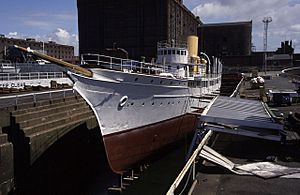Clarence Dock, Liverpool facts for kids
Quick facts for kids Clarence Dock |
|
|---|---|

Clarence Dock entrance
|
|
| Location | |
| Location | Vauxhall, Liverpool, United Kingdom |
| Coordinates | 53°25′09″N 3°00′07″W / 53.4191°N 3.0019°W |
| OS grid | SJ334918 |
| Details | |
| Opened | 16 September 1830 |
| Closed | 1928 |
| Type | Wet dock |
| Area | 6 acres (2.4 ha), 273 sq yd (228 m2) |
| Width at entrance | 47 ft (14 m) |
| Quay length | 914 yd (836 m) |
Clarence Dock was a very important dock in Liverpool, England. It was located right on the River Mersey and was a key part of the huge Port of Liverpool. You could find it in the northern part of the city's dock system, and it was even connected to another dock called Trafalgar Dock.
Contents
History of Clarence Dock
Clarence Dock was designed by a famous engineer named Jesse Hartley. It first opened its gates on September 16, 1830. The dock was named after William, Duke of Clarence, who later became King William IV.
Why Clarence Dock Was Special
This dock was built in a special way to handle steamships. Back then, most ships were made of wood. Steamships had engines that used fire, which could be dangerous. By having a separate dock for them, it helped prevent fires from spreading to the wooden sailing ships in other docks.
A Gateway for Irish People
Clarence Dock became the main place where ferry ships from Ireland would arrive. This was especially important during the Irish famine in the 1840s. Over 1.3 million Irish people traveled through this dock looking for a better life.
Many of them then took another ship from Waterloo Dock to America, as there weren't many direct trips from Ireland to America at that time. However, thousands of people decided to make Liverpool their new home. Others moved to different towns and cities in Britain to find work.
The Dock Closes
Clarence Dock stopped being used in 1928. The very next year, in 1929, it was filled in. The area was then redeveloped to build a large power station.
Clarence Dock Power Station
The Clarence Dock power station was built in 1931 for Liverpool Corporation. Its job was to create electricity for the entire city of Liverpool. The station had two main parts: a low-pressure section (called No. 1) and a high-pressure section (No. 2). Both used coal to heat water, creating steam that powered large machines called alternators to make electricity.
The power station was a huge source of energy for Liverpool for many years. By 1972, the No. 1 section was no longer in use. The No. 2 section was changed to use oil instead of coal. The entire power station was eventually shut down in the early 1980s.
The power station had three very tall chimneys that were a well-known sight in Liverpool. People called them the Three Sisters. These chimneys stood tall until the power station was taken down in 1994.
Clarence Dock Today
Even though the main dock was filled in, two parts of it, called the Clarence Graving Docks, are still there. You can reach them through what's left of Trafalgar Dock. These graving docks are used for repairing ships.
In 2006, the famous Irish pop band Westlife even held a concert at Clarence Dock for their "Face to Face Tour"!
Future Plans for the Area
There are big plans for the Clarence Dock area as part of the Liverpool Waters development. This project aims to build many tall buildings in the area. Clarence Dock is one of the main spots chosen for these new high-rise buildings. These plans have been agreed upon by Peel Holdings and English Heritage.
There were also talks about building a new stadium for Everton FC near the Mersey in 2004, which would have included a special train service. However, this idea didn't happen. But in 2016, the northern docks, including the Clarence Dock area, were again considered as a possible location for a new stadium for Everton.


